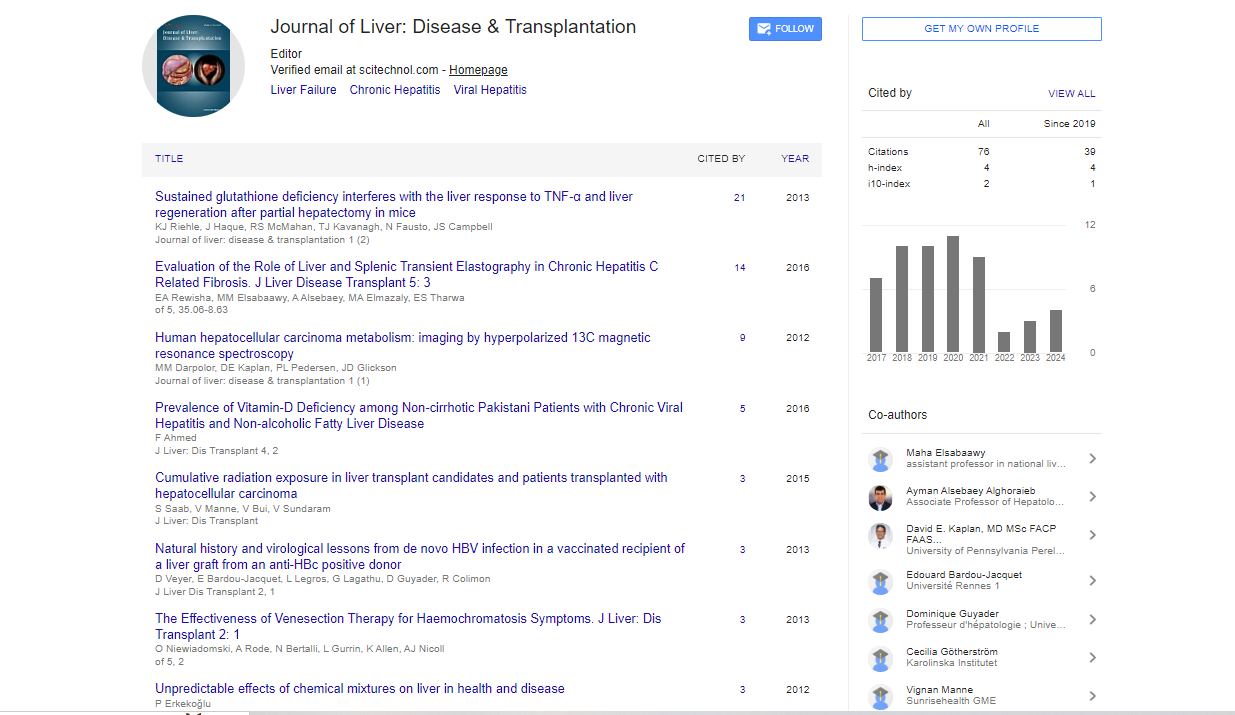Opinion Article, J Liver Disease Transplant Vol: 13 Issue: 1
Ascites: Understanding the Pathophysiology, Clinical Manifestations, and Management Strategies
Liu Pong*
1Department of Gastroenterology, Renmin Hospital of Wuhan University, Wuhan, China
*Corresponding Author: Liu Pong,
Department of Gastroenterology, Renmin
Hospital of Wuhan University, Wuhan, China
E-mail: pl@whu.edu.cn
Received date: 12 February, 2024, Manuscript No. JLDT-24-135111;
Editor assigned date: 14 February, 2024, PreQC No. JLDT-24-135111 (PQ);
Reviewed date: 28 February, 2024, QC No. JLDT-24-135111;
Revised date: 06 March, 2024, Manuscript No. JLDT-24-135111 (R);
Published date: 13 March, 2024, DOI: 10.4172/2325-9612.1000255.
Citation: Pong L (2024) Ascites: Understanding the Pathophysiology, Clinical Manifestations, and Management Strategies. J Liver Disease Transplant 13:1.
Description
Ascites is a common clinical manifestation of numerous underlying diseases, particularly advanced liver cirrhosis, heart failure, and certain malignancies. Characterized by the abnormal accumulation of fluid within the peritoneal cavity, ascites presents a complex challenge for healthcare providers due to its diverse etiologies and potential complications. The development of ascites is primarily attributed to alterations in the intricate balance of hydrostatic and oncotic pressures within the splanchnic circulation. In liver cirrhosis, for instance, the progressive hepatic fibrosis disrupts the architectural integrity of the liver parenchyma, leading to increased resistance to portal blood flow. Consequently, portal hypertension ensues, causing a redirection of blood flow to collateral vessels and the splanchnic vasculature. This results in an elevation of hydrostatic pressure within the hepatic sinusoids and subsequent transudation of fluid into the peritoneal cavity.
Moreover, the systemic vasodilation accompanying cirrhosis triggers a compensatory activation of vasoconstrictor mechanisms, such as the renin-angiotensin-aldosterone system and the sympathetic nervous system. These neurohumoral responses aim to restore arterial blood pressure; however, they inadvertently exacerbate renal sodium and water retention, further contributing to ascites formation. In addition to cirrhosis, other conditions such as congestive heart failure, nephrotic syndrome, and malignancies can also precipitate ascites through distinct pathophysiological mechanisms. These may involve impaired cardiac function, renal sodium retention, or peritoneal carcinomatosis leading to increased vascular permeability and lymphatic obstruction.
The clinical presentation of ascites varies depending on its severity and underlying etiology. In its early stages, patients may remain asymptomatic, with the detection of ascites often incidental during routine physical examination or imaging studies. As the volume of ascites increases, individuals may experience abdominal distension, discomfort, and a progressive increase in abdominal girth.
Furthermore, patients with massive ascites may develop complications such as umbilical hernias, respiratory compromise secondary to diaphragmatic elevation, and lower extremity edema due to increased intra-abdominal pressure impeding venous return. Moreover, the presence of ascites heralds advanced disease progression in conditions such as cirrhosis and malignancies, carrying significant prognostic implications.
The diagnosis of ascites typically relies on a combination of clinical evaluation, imaging studies, and diagnostic paracentesis. Physical examination may reveal shifting dullness, fluid thrill, and a bulging flanks signifying the presence of ascites. Abdominal ultrasound serves as the initial imaging modality of choice, allowing visualization of fluid accumulation and assessment of hepatic and splenic morphology. Diagnostic paracentesis, involving the aspiration of ascitic fluid for analysis, is essential for confirming the diagnosis and guiding further management. Analysis of ascitic fluid includes assessment of cell count, protein concentration, albumin gradient, and culture to differentiate between transudative and exudative causes of ascites and identify potential infectious etiologies.
Furthermore, additional investigations such as Serum Ascites Albumin Gradient (SAAG), ascitic fluid cytology, and imaging studies (e.g., computed tomography) may be warranted to elucidate the underlying etiology and assess for complications such as hepatocellular carcinoma or spontaneous bacterial peritonitis. The management of ascites encompasses a multifaceted approach aimed at alleviating symptoms, addressing underlying etiologies, and preventing complications. Dietary sodium restriction (<2 g/day) and diuretic therapy constitute the cornerstone of medical management, with loop diuretics (e.g., furosemide) and aldosterone antagonists (e.g., spironolactone) commonly utilized to promote natriuresis and reduce intravascular volume.
In refractory cases or those complicated by spontaneous bacterial peritonitis, therapeutic paracentesis may be indicated to provide symptomatic relief and facilitate diagnostic evaluation. Additionally, the use of albumin infusion following large-volume paracentesis helps prevent circulatory dysfunction and renal impairment by restoring intravascular oncotic pressure. For patients with cirrhosis, liver transplantation remains the definitive treatment option, offering the potential for resolution of ascites and improved long-term survival. However, transplantation candidacy depends on various factors, including disease severity, comorbidities, and patient preference.
Conclusion
Ascites represents a significant clinical manifestation of various underlying diseases, necessitating a comprehensive understanding of its pathophysiology, clinical manifestations, and management strategies. Through a systematic diagnostic approach and individualized therapeutic interventions, healthcare providers can effectively manage ascites, mitigate complications, and optimize patient outcomes. Future study and efforts should focus on elucidating novel therapeutic targets and refining existing management algorithms to further enhance the care of patients with ascites.
 Spanish
Spanish  Chinese
Chinese  Russian
Russian  German
German  French
French  Japanese
Japanese  Portuguese
Portuguese  Hindi
Hindi 